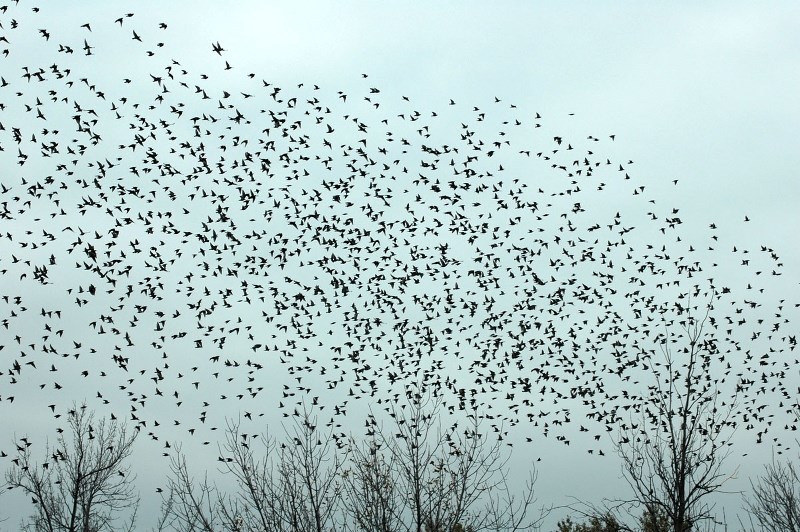Birds of a feather flock together.
The real question is how.
It's a question that's been in the back of my head ever since I first saw a roiling cloud of bohemian waxwings devour the mountain ash tree outside my house.
They'd be gobbling berries at one moment only to explode into flight the next, transforming from a chaotic mob into a synchronized unit in a blink of an eye. They'd loop and twist through the air at wicked speeds in perfect unison like a sort of intoxicated version of The Snowbirds.
While many birds fly in flocks, the only ones around here that form huge swarms are waxwings and starlings, says St. Albert birder Peter Demulder.
Both these species are known to instantly change direction in unison when flying in flocks despite not having a lead bird to direct them, transforming from individual birds into a sort of amorphous, hyperactive feathery blob.
Birds generally flock together for protection, says Stuart Mackenzie, a biologist with Bird Studies Canada based at Ontario's Long Point Bird Observatory.
"The probability of being eaten is less if there are more of your friends nearby," he explains, as they can help you spot predators or get eaten in your stead.
Flying in a huge flock can also help surprise or dazzle predators, notes Peter Friederici, writing for the Audubon Society. Dunlins have dark tops and light undersides, for example, so a swarm of them can suddenly change colour simply by turning in unison.
How it works
Exactly how these huge flocks turn in unison, and so quickly, is still largely unknown due in most part to the fact that it's tough to get a few hundred birds flying in a lab at once. Researchers were so lost on the subject a century ago that some suggested telepathy or neurological radio as explanations, Friederici writes.
Russian scientist Dmitrii Radakov made the first big breakthrough in the 1960s with his work on schools of fish, which move very much like bird swarms, Friederici writes. Radakov determined that a school could avoid a threat if one fish spotted the threat and everyone else copied its reaction, causing the school to turn as one. Any movement action would ripple through the flock like waves in a crowd.
This also helps explain why flocks move so erratically; as there's no one clear leader, the swarm will twist and turn here and there as different members react to different threats.
Biologist Wayne Potts refined this theory when he determined that birds could not react this fast if they simply copied their nearest neighbours. Instead, much like dancers in a chorus line, they had to watch many neighbours at once.
But it wasn't until the last few decades that computers and high-speed cameras were advanced enough for researchers to confirm these theories.
By filming swarms of starlings from three different angles and constructing a 3D model, physicist Andrea Cavagna and his team at the Institute for Complex Systems in Rome have been able to study the movements of about 2,600 individual birds in a flock.
"When a flock is subject to predation by a falcon, for example, it changes its shape and even its density very, very drastically and very, very quickly," he says.
Cavagna's team found that a change in a flock starts with just one starling and ripples out to the rest of the flock as each bird copies its neighbour. The change moves like a wave through the flock at about 144 kilometres an hour, allowing the flock to change direction in a blink of an eye.
"It's quick, but it's not instantaneous."
Cavagna's team also determined that the birds were taking their signals from a specific number of neighbours – about seven – instead of all those within a set distance as was previously thought.
What Cavagna and others haven't been able to figure out is how this signal to change direction moves between each bird – it's probably a combination of sight and really fast reaction times, but there could also be sound or air pressure cues at work.
They're also unsure of how the signal stays clear despite being passed between hundreds of birds in a sort of giant, super-fast game of Telephone, Cavagna notes.
"It's certainly something quite useful for the flock."
So how do birds of a feather flock together? The answer, for now, at least, is "very well."




